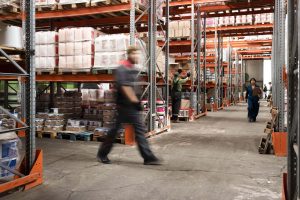This is the time of ever-escalating customer expectations driven by competitors ready to match those exacting standards. In competitive domains like retail and eCommerce domain, it’s now apparent that companies require to maintain a high throughput across their entire customer-facing operations. By definition, throughput is the volume of orders that retailers can deliver to any client within a specified time frame. While this term may sound too simplistic or overly focused on logistical efficiency, it’s emerging as a critical parameter in any effective order fulfillment process.
That said, warehouses, distribution centers, and micro fulfillment centers face multiple barriers to improving their throughput to achieve the desired order fulfillment outcomes. Unfortunately, falling short can have serious consequences.
38% of online shoppers abandon their order if they believe the fulfillment time exceeds a week. Nearly 70% of shoppers are unlikely to buy from a retailer who doesn’t deliver inside 2 days of the delivery date. Among the latest developments, customers are demanding same-day deliveries, which makes high throughput even more critical in distribution centers (DCs).
Besides faster deliveries, high throughput offers multiple benefits to order fulfillment across DCs. Here are 5 of these benefits:
- Faster accurate product searches
In a competitive industry, companies cannot lose time and effort in searching for products or SKUs to create totes for timely shipments. An extensive and time-consuming search process can also increase the chances of a mis-pick and significantly impact the customer’s satisfaction levels.
With high throughput, warehouse managers can store products at optimal storage locations, thus enabling faster searches. Based on their throughput, products have a proper slot within the facility, which also reduces the workload for warehouse personnel. Apart from improving employee morale, faster product searches can facilitate same-day deliveries.
- SKU organization
Companies focused on high throughput efficiency also organize their SKUs based on customer demand. Be it an individual (or batch) product pick, every product SKU now has a fixed address (or slot) in a distribution center or warehouse. An organized SKU is also crucial in DCs with limited storage space.
An organized SKU strategy offers a host of tangible benefits like:
- Reduced search and pick time
- Lower costs
- Improved workforce morale
- Higher profits
- Time efficiency
Throughput in order fulfillment is all about achieving time efficiency from the start to the finish. Here are 4 steps where retailers can achieve efficiency in throughput time:
- Processing time or the time taken to provision a product.
- Inspection time or the time taken to inspect the finished product for quality control.
- Transportation time or the time taken to move the product from the delivery center to the customer.
- Wait time or the idle time spent between these activities.
To achieve high throughput, companies try to address any delays in each of these steps. They can strive for fulfillment time efficiency by addressing any process bottlenecks at any stage.
- Order accuracy
23% of product returns happen when shoppers receive the wrong product in the first place. Returned products cost businesses 66% of the price of the original item. On average, inaccurate order deliveries cost $36 after considering the costs of transportation, repackaging, and restocking.
Besides accelerating order fulfillment, companies focusing on high throughput can also improve their order accuracy. Automated fulfillment solutions reduce the chances of human errors, thus ensuring that the right product is picked and delivered to customers.
- Labor cost efficiency
Labor costs account for 60 to 80% of the operational expenses in order fulfillment. Additionally, order-picking activities cost between 50 to 70% of the fulfillment-related expenses. Besides order pickups and deliveries, labor resources are needed to handle product returns and replacements.
By improving the throughput, companies can reduce their labor costs. For instance, an optimized warehouse layout can reduce the worker’s travel time to storage facilities. Companies can also improve their order accuracy by using automation technology to assist operators in finding the right product.
How to improve throughput in order fulfillment
Despite the many benefits, companies often struggle to accelerate throughput in their order fulfillment process. Here are some best practices to improve throughput:
- Optimized layout in warehouses and fulfillment centers
- Use of barcodes to locate products.
- Automation technologies to reduce human errors during order picking, moving, and other human activities.
- Real-time monitoring of the entire order fulfillment process to identify bottlenecks or areas of improvement.
- Improved last-mile fulfillment by switching to micro fulfillment centers (MFCs) or dark stores.
Additionally, companies must also optimize their product return process to reduce the customer’s wait time and frustration. With reverse logistics, they can reduce the costs of returned products – and maintain a consistent flow of orders.
Conclusion
To stay competitive, it’s critical for retailers to understand the importance of high throughput in order fulfillment. Automated solutions in fulfillment are the way forward for optimizing last-mile deliveries and reverse logistics.
Cartesian Kinetics is driving the next phase of high throughput order fulfillment with its automation solution, Carte+, With this solution, companies can now achieve a high throughput of over 450 totes per hour.
You can experience the difference that Carte+ makes to your order fulfillment. To know more, reach out to us today!





